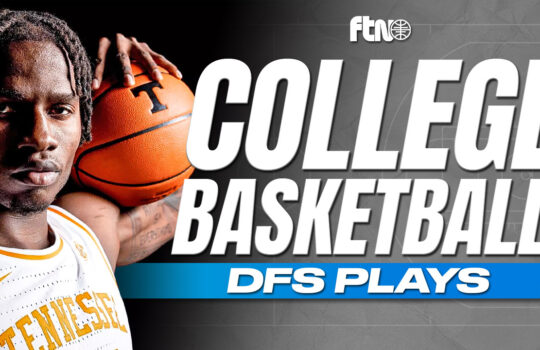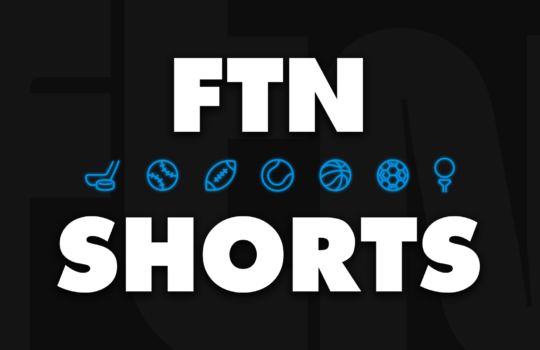
Data in baseball runs deeper and is more comprehensive than in any other sport. In fact, there are so many stats that, in virtually every matchup, you can find a stat to favor each side.
Rather, we want to find stats that are fully supported by the collection of data, painting one clear picture. These are the seven stats I find most relevant to Monday’s DFS slate.
1. 38.1%
It’s hard to overstate Spencer Strider’s brilliance this season. Among pitchers with at least 100 innings pitched, Shohei Ohtani is second with a 33.0% K rate. Strider is first at 38.1%. For context, that 5.1 percentage-point gap is larger than the gap between second place and 16th place.
Strider gets SF and their 27.8% K rate over the last 14 days, making him an absolute lock for me. I also threw a K ladder bet series for him into the Bet Tracker.
2. 34.5%
Ryne Nelson was phenomenal in his MLB debut against San Diego. He threw seven scoreless innings with a 7:0 K:BB ratio. His stellar performance was backed by a 34.5% CSW, showing that he wasn’t lucky in the game – he was just flat out good.
I don’t have much interest in him tonight, but I do think his impressive performance means I’ll be fading a chalky Dodgers team, as they have the highest implied run total by almost half a run.
3. 12.1%
Bryan Hoeing struck out just 12.1% of AAA hitters this season. That’s a remarkably low number, and his 22.6% CSW in his MLB debut suggests it will remain super low at the big-league level.
A pitcher with such inability to miss bats has to rely on producing soft contact. However, Hoeing allowed hard contact throughout his debut:
So, we have a pitcher who can’t miss bats, yet gives up dangerous contact anyway, facing an offense (Texas) full of hitters who either swing and miss or drive the ball. This is a match made in heaven for the boom-or-bust Rangers.
4. .212
.212 is Bryse Wilson’s baseline ISO allowed. His Statcast data paints an equally intriguing picture:
Of course, it’s also important to note that while Cincinnati isn’t the greatest offense, Great American Ball Park is Coors Field Lite. This season, it’s boosted HRs by an estimated 38% according to Statcast’s park factors, with a 48% boost dating back to the 2020 season. The result is a slate-leading .282 projected ISO for a really cheap Cincinnati stack.
5. 92.6
The pitcher on tonight’s slate with the largest difference between their baseline and L30 day Statcast profile has to be Alex Cobb:
Atlanta hits the ball hard against everyone, so they can certainly take advantage of this downward trend from Cobb. Additionally, they project really well against Cobb’s sinker-splitter profile:
- wSI/C = runs gained against the sinker per 100 pitches
- wFS/C = runs gained against the splitter per 100 pitches
6. .172
José Berríos’ .172 baseline ISO allowed is higher than the typical pitcher with a SIERA under 4.0. This is who Berrios is, and it’s backed by his Statcast data – he’s a good pitcher, but when he gets hit, he gets hit hard:
Tampa has a chance to take full advantage at extremely low ownership. Tampa lacks the HR upside of most popular stacks, but they make up for it by stringing together sustained rallies, so I prefer a primary stack over a mini-stack to maximize the correlation benefit.
7. 15.2
Framber Valdez has an underwhelming 22.5% baseline K rate. However, his elite 15.2 pitch per inning ratio tells us he has the potential for more Ks. This potential has been realized in the last 30 days – his CSW has jumped from 28.7% to 31.4%, resulting in a K rate north of 28%.
He should be able to continue this string of success against the Tigers, making him my preferred option with Strider over a chalkier Chris Bassitt and his troubling CSW trend.

















































 New York Jets
New York Jets  New England Patriots
New England Patriots  Miami Dolphins
Miami Dolphins  Buffalo Bills
Buffalo Bills  Pittsburgh Steelers
Pittsburgh Steelers  Cleveland Browns
Cleveland Browns  Cincinnati Bengals
Cincinnati Bengals  Baltimore Ravens
Baltimore Ravens  Tennessee Titans
Tennessee Titans  Jacksonville Jaguars
Jacksonville Jaguars  Indianapolis Colts
Indianapolis Colts  Houston Texans
Houston Texans  Las Vegas Raiders
Las Vegas Raiders  Los Angeles Chargers
Los Angeles Chargers  Kansas City Chiefs
Kansas City Chiefs  Denver Broncos
Denver Broncos  Washington Commanders
Washington Commanders  Philadelphia Eagles
Philadelphia Eagles  New York Giants
New York Giants  Dallas Cowboys
Dallas Cowboys  Minnesota Vikings
Minnesota Vikings  Green Bay Packers
Green Bay Packers  Detroit Lions
Detroit Lions  Chicago Bears
Chicago Bears  Tampa Bay Buccaneers
Tampa Bay Buccaneers  New Orleans Saints
New Orleans Saints  Carolina Panthers
Carolina Panthers  Atlanta Falcons
Atlanta Falcons  San Francisco 49ers
San Francisco 49ers  Seattle Seahawks
Seattle Seahawks  Los Angeles Rams
Los Angeles Rams  Arizona Cardinals
Arizona Cardinals 





 Boston Celtics
Boston Celtics  Brooklyn Nets
Brooklyn Nets  Philadelphia 76ers
Philadelphia 76ers  New York Knicks
New York Knicks  Toronto Raptors
Toronto Raptors  Chicago Bulls
Chicago Bulls  Detroit Pistons
Detroit Pistons  Milwaukee Bucks
Milwaukee Bucks  Cleveland Cavaliers
Cleveland Cavaliers  Indiana Pacers
Indiana Pacers  Orlando Magic
Orlando Magic  Atlanta Hawks
Atlanta Hawks  Charlotte Hornets
Charlotte Hornets  Miami Heat
Miami Heat  Washington Wizards
Washington Wizards  Denver Nuggets
Denver Nuggets  Minnesota Timberwolves
Minnesota Timberwolves  Oklahoma City Thunder
Oklahoma City Thunder  Portland Trail Blazers
Portland Trail Blazers  Utah Jazz
Utah Jazz  LA Clippers
LA Clippers  Golden State Warriors
Golden State Warriors  Los Angeles Lakers
Los Angeles Lakers  Phoenix Suns
Phoenix Suns  Sacramento Kings
Sacramento Kings  Dallas Mavericks
Dallas Mavericks  Houston Rockets
Houston Rockets  Memphis Grizzlies
Memphis Grizzlies  New Orleans Pelicans
New Orleans Pelicans  San Antonio Spurs
San Antonio Spurs 










